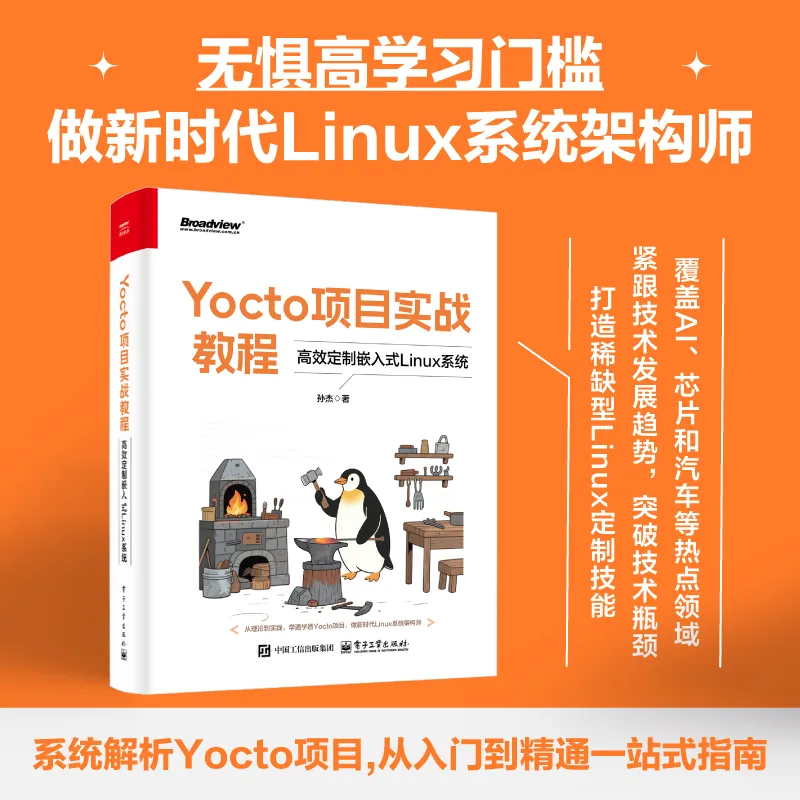01
- Modular Build System: The Yocto Project uses the BitBake build tool, allowing developers to easily add, remove, or modify packages, including Qt SDK and OpenSSL.
- Flexibility and Customizability: Developers can highly customize the system according to project requirements, supporting various hardware architectures and operating system configurations, ensuring that components like Qt and OpenSSL are suitable for specific application scenarios.
- Support for Multiple Hardware Platforms: The Yocto Project can be used to build Linux systems on various embedded devices, supporting multiple hardware architectures such as ARM and x86, ensuring that components like Qt SDK and OpenSSL run smoothly across different platforms.
- Open Source Toolchain: All toolchains and build environments are open source, allowing developers to freely use and modify them, including the compilation and configuration of Qt SDK and OpenSSL.
- Strong Community Support: The Yocto Project has an active developer community that provides rich resources and documentation to help developers solve problems encountered when integrating components like Qt SDK and OpenSSL.
- Automated Testing: The Yocto Project includes an automated testing framework that ensures the stability and security of components like Qt SDK and OpenSSL.
- Hierarchical Configuration Management: The Yocto Project uses a layered configuration approach, making it easy to manage different product lines and configuration requirements, ensuring that different versions and configurations of components like Qt SDK and OpenSSL can be flexibly combined.
- Security: The project provides strong security and update mechanisms to help protect end users from security threats, including management of security patches and updates for components like Qt SDK and OpenSSL.
- Support for the Latest Technology Trends: Due to its open-source and community-driven nature, the Yocto Project can quickly integrate the latest technologies and standards, including the latest versions and features of Qt SDK and OpenSSL.
- Continuous Integration and Continuous Deployment: Through the Yocto Project, developers can achieve continuous integration and continuous deployment, improving development efficiency and product quality, ensuring that updates to components like Qt SDK and OpenSSL can be quickly reflected in the final product.
Currently, embedded development is experiencing a new wave, with embedded Linux systems widely used in domestic chips, smart homes, industrial control, smart vehicles, and playing a key role in AIoT (Artificial Intelligence of Things), edge computing, and smart healthcare.
However, the development of embedded Linux systems faces many challenges.
-
Fragmented Hardware Ecosystem: This leads to high adaptation and maintenance costs.
-
Customization Requirements: These require deep optimization for boot speed, power consumption, real-time performance, and security.
-
Complex Development Process: This involves kernel trimming, driver adaptation, cross-compilation, and software stack integration.
-
Chaotic Version Management: This results in lengthy cycles.
Moreover, the difficulty of optimizing software and hardware in coordination, limited resources on different platforms, and the challenge of applying optimization strategies universally further raise the development threshold, making the core position of embedded Linux systems in smart devices face higher technical challenges.
The Emergence of Yocto
Before the Yocto Project was born, one of the most commonly used embedded Linux build tools on the market was Buildroot. Although Buildroot can provide a simple embedded system in a short time, its limitations lie in its insufficient support for complex projects and frequently changing software and hardware requirements. As the scale of embedded development projects expands, Buildroot’s customizability and scalability gradually become inadequate. In complex projects that require extensive customization and frequent builds, Buildroot’s functionality fails to effectively meet developers’ demands for more powerful tools.
To address these challenges, the Yocto Project was born. The Yocto Project not only inherits the rapid build advantages of Buildroot but also compensates for its shortcomings by introducing highly customizable toolchains and extensive hardware support. The Yocto Project provides a flexible, scalable, and automated build toolset. It adopts a modular architecture, layered build system, and software stack management mechanism, enabling developers to efficiently customize, optimize, and maintain embedded Linux systems, improving development efficiency and reducing adaptation costs.
The Yocto Project has become the mainstream tool for customizing embedded Linux systems, but due to its complex build system, flexible configuration, and debugging difficulties, its “difficult to learn but easy to use” characteristic deters many developers.
Developers often encounter unique challenges that arise from both its highly flexible workflow and its complex build environment and performance requirements. According to the official description of the Yocto Project, the main challenges can be summarized into three categories:
-
Learning Curve and Understanding Costs:
-
Complexity of Workflow and Build Environment:
-
Initial Build Time and Performance Issues:
To help everyone master the Yocto Project more efficiently, the new book “Yocto Project Practical Tutorial: Efficiently Customizing Embedded Linux Systems” has emerged. This book builds on the official documentation and combines the author’s years of embedded development experience to distill the core theoretical framework, making it easy to read and understand. It is also supplemented with numerous practical cases to help readers systematically learn the Yocto Project and quickly grasp the foundational knowledge and practical skills of the Yocto Project.
 About the Author The author of this book, Sun Jie, is a senior embedded software engineer. He has long been deeply involved in the Yocto Project, from technical learning to engineering practice, and then to community sharing. He has not only accumulated rich experience but also possesses the ability to systematize and structure complex problems. This book is a distillation of his years of development experience, providing a comprehensive analysis of the theoretical system of the Yocto Project, along with practical cases using the QEMU simulator, Raspberry Pi teaching development board, and NXP i.MX 8M Plus high-end chip, offering a clear and actionable learning path for developers at different learning stages. Whether you are a beginner embedded engineer or a senior developer looking to master the Yocto Project, you will find valuable content in this book.
About the Author The author of this book, Sun Jie, is a senior embedded software engineer. He has long been deeply involved in the Yocto Project, from technical learning to engineering practice, and then to community sharing. He has not only accumulated rich experience but also possesses the ability to systematize and structure complex problems. This book is a distillation of his years of development experience, providing a comprehensive analysis of the theoretical system of the Yocto Project, along with practical cases using the QEMU simulator, Raspberry Pi teaching development board, and NXP i.MX 8M Plus high-end chip, offering a clear and actionable learning path for developers at different learning stages. Whether you are a beginner embedded engineer or a senior developer looking to master the Yocto Project, you will find valuable content in this book. Structural Highlights + Accompanying Videos
Structural Highlights + Accompanying Videos
This book closely integrates the core concepts and practical cases of the Yocto Project, with a clear structure, distinct layers, and a gradual approach, effectively combining theoretical learning and practical application. The content of the book is generally divided into three parts.
Part One: Systematically and concisely introduces the basic framework and core components of the Yocto Project, including metadata structure, BitBake build engine, Poky reference distribution, image recipes, and kernel recipes, among other key knowledge points. Benefiting from the author’s years of in-depth research, these chapters are not merely direct transfers of official knowledge or simple translations, but rather the author’s organization and transmission of the complete knowledge system of the Yocto Project.
Part Two: Uses customizing a Raspberry Pi system as an introductory case, discussing two core knowledge points commonly used in practice: BSP customization and SDK generation, allowing beginners to quickly learn and use the core technologies of the Yocto Project with minimal learning costs. Learning through practice, combined with the knowledge system from the previous chapters and the widespread application foundation of Raspberry Pi, makes the first step in practical Yocto Project work agile and effective.
Part Three: Uses the NXP i.MX 8M Plus chip development as a case study, introducing the complete process of system development in industrial scenarios. This effectively helps developers transition from beginner to advanced in the Yocto Project, fully experiencing and leveraging the development advantages of the Yocto Project, aiding developers in achieving efficient advancement.
 New Book Launch Limited-Time Discount
New Book Launch Limited-Time Discount
It is believed that for both beginners and developers with some experience who need to advance, through the study of various chapters in this book, they can truly use the Yocto Project to develop embedded Linux systems in an agile and efficient manner.